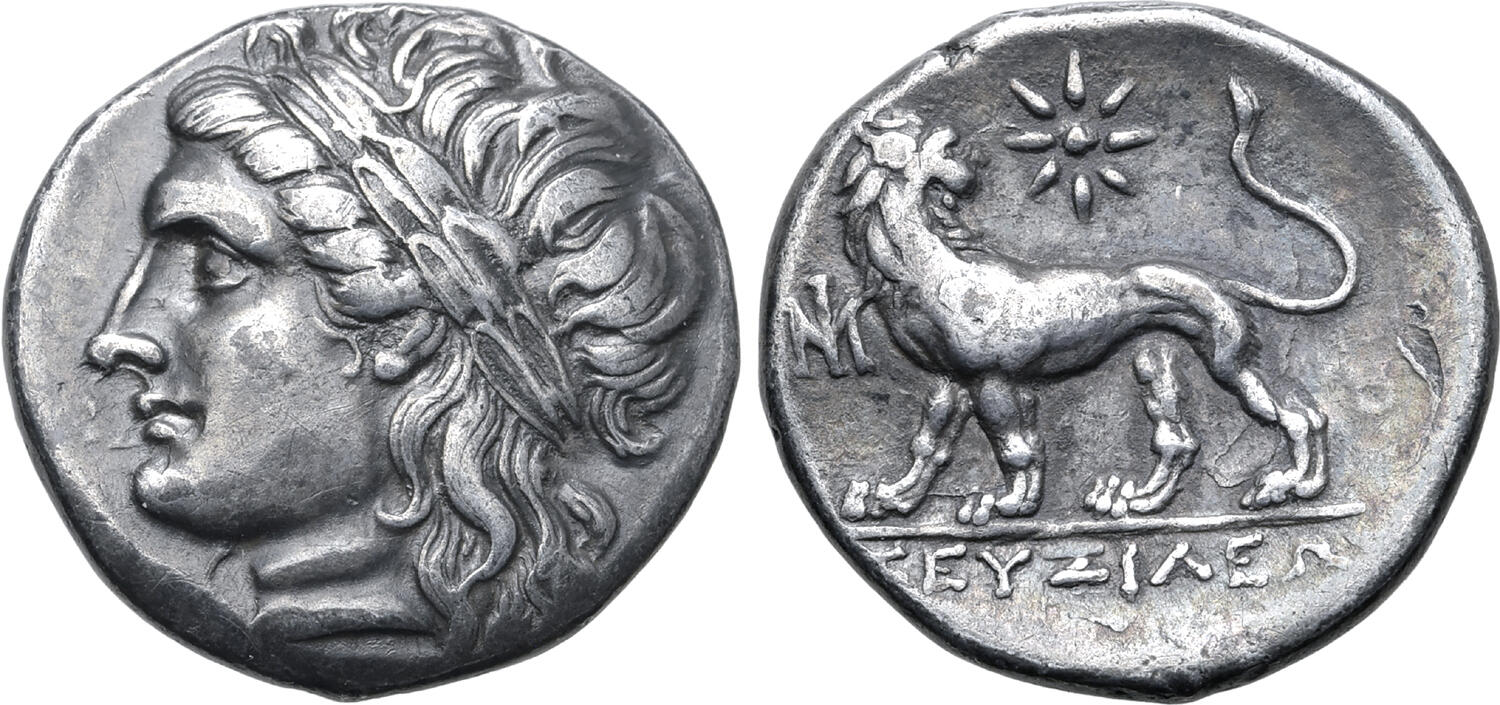Miletus, silver, didrachms (294-281 BCE)
From SILVER
294 BCE - 281 BCE Silver 6,872 kg
Description
| ObverseInscription or printing placed on the obverse.: | Head of Apollo left, wearing laurel wreath. |
| ReverseInscription or printing placed on the reverse.: | monogram of the city (Greek).Lion standing to left, head reverted, star with eight rays above, monogram before, ZEYΞIΛEOΣ in exergue. |
Mint and issuing power
| MintIdentifies the place of manufacture or issue of a numismatic object.: | Miletus | Ancient regionAncient region.: | Ionia | Modern countryModern country: Turkey | AuthorityIdentifies the issuing power. The authority can be "pretended" when the name or the portrait of X is on the coin but he/she was not the issuing power. It can also be "uncertain" when there is no mention of X on the coin but he/she was the issuing power according to the historical sources: |
Chronology
| FromIdentifies the initial date in a range assigned in a numismatic context. | 294 BCE | toIdentifies the final date in a range assigned in a numismatic context.. | 281 BCE | PeriodTime period of the numismatic object.: Hellenistic 323-30 BC |
Physical description
| MetalThe physical material (usually metal) from which an object is made.: | Silver |
Median weightMedian of the weights of numismatic objects (in grams). in grams | 6.50 | DenominationTerm indicating the value of a numismatic object. Examples: tetradrachm, chalkous, denarius.: | didrachm |
StandardStandard.: |
Image

H226 Miletus didrachm.jpeg [1]
References
| Die study referencePublication of the study: | Deppert-Lippitz 19841Deppert-Lippitz 1984 | ||
| Coin series referenceReference to coin series study: | Sear II2Sear II, n° 4505, RQEMH3RQEMH, n° 226 | ||
| Coin series web referenceCoin series web references: | |||
Obverse dies distribution
| FrequencyFrequency of specimen in distribution. ᵖ | Number of obversesNumber of obverse dies. ᵖ (o) | % (o) | Number of coinsNumber of coins. (n) | % (n) | Die nameName(s) of the die(s). |
| 1 | 21 | 60 | 21 | 27.27 | 3, 4, 9, 10, 12, 13, 15, 16, 17, 19, 20, 21, 22, 23, 26, 28, 29, 30, 33, 34, 35 |
| 2 | 5 | 14.29 | 10 | 12.99 | 2, 7, 11, 21, 25 |
| 3 | 2 | 5.71 | 6 | 7.79 | 5, 14 |
| 4 | 3 | 8.57 | 12 | 15.58 | 1, 18, 27 |
| 5 | 2 | 5.71 | 10 | 12.99 | 6, 8 |
| 8 | 1 | 2.86 | 8 | 10.39 | 31 |
| 10 | 1 | 2.86 | 10 | 12.99 | 32 |
| Total | 35 of 35 | 100 | 77 of 77 | 100 |
Reverse dies distribution
no distribution is available
Quantification
| Number of obversesNumber of obverse dies. ᵖ (o) | 35 | Number of singletons (o1)The number of singleton coins. ᵖ | 21 |
| Number of reverse diesNumber of reverse dies. (r) | 54 | Number of coinsNumber of coins. (n) | 77 |
| Coins per obverse dieNumber of coins per obverse die. (n/o) | 2.2 | Coins per reverse dieNumber of coins per reverse die. (n/r) | 1.43 |
| Reverse per obverse ratioRatio of obverse dies divided by reverse dies. (r/o) | 1.54 | Percentage of singletons (o1)number of coins (n) divided by the number of singletons (o1) ᵖ | 60 % |
| Original number of dies (O) (Carter 1983 formula)The estimation of the number of coins according to Carter 1983 ᵖ | 52.86 | Coins struck if 20,000 as average productivity per dieCoins made if the average productivity for obverses (according to Carter) is 20,000. ᵖ | 1,057,200 |
| Original number of dies (O) (Esty 2011 formula)The estimation of the number of coins according to the singleton formula in Esty 2011 ᵖ (O) | 64.17 | Survival rate if 20,000 as average productivity per dieSurvival rate if average productivity is 20,000. ᵖ | 0.00007 |
| Coverage (o = % of O) (Esty 1984 formula)Esty 1984 - coverage (% of O) ᵖ (o = % of O) | 72.73% | Die productivity if survival rate 1/2,000Average productivity if survival rate is 1/2,000. ᵖ | 2,913.36 |
| Weight of silver (in kg) if 20,000 coins per die (O = Carter formula)Carter 1983 * Median weight * 20000 (*10 if gold or electrum) ᵖ | 6,872 kg <br /> 6,872 kg | Die productivity if survival rate 1/5,000Average productivity if survival rate is 1/5,000. ᵖ | 7,283.39 |
Remarks
Most likely one single workstation